Exercise 1.12. Consider the following game. There is a club with three members: Ann, Bob and Carla. They have to choose which of the three is going to be president next year. Currently Ann is the president. Each member is both a candidate and a voter. Voting is as follows: each member votes for one candidate (voting for oneself is allowed); if two or more people vote for the same candidate then that person is chosen as the next president; if there is complete disagreement, in the sense that there is exactly one vote for each candidate, then the person from whom Ann voted is selected as the next president. (a) Represent this voting procedure as a game frame, indicating inside each cell of each table which candidate is elected. (b) Assume that the players' preferences are as follows: Ann A Carla Ann Bob, Carla Bob Bob Bob Ann, Bob Carla Ann Carla Carla. Using utility values 0, 1 and 2, convert the game frame into a game. (c) Apply the IDWDS to the game of part (b). Is there a weak iterated dominant- strategy equilibrium? (d) Does the extra power given to Ann (in the form of tie-breaking in case of complete disagreement) benefit Ann?
Exercise 1.12. Consider the following game. There is a club with three members: Ann, Bob and Carla. They have to choose which of the three is going to be president next year. Currently Ann is the president. Each member is both a candidate and a voter. Voting is as follows: each member votes for one candidate (voting for oneself is allowed); if two or more people vote for the same candidate then that person is chosen as the next president; if there is complete disagreement, in the sense that there is exactly one vote for each candidate, then the person from whom Ann voted is selected as the next president. (a) Represent this voting procedure as a game frame, indicating inside each cell of each table which candidate is elected. (b) Assume that the players' preferences are as follows: Ann A Carla Ann Bob, Carla Bob Bob Bob Ann, Bob Carla Ann Carla Carla. Using utility values 0, 1 and 2, convert the game frame into a game. (c) Apply the IDWDS to the game of part (b). Is there a weak iterated dominant- strategy equilibrium? (d) Does the extra power given to Ann (in the form of tie-breaking in case of complete disagreement) benefit Ann?
Principles of Microeconomics (MindTap Course List)
8th Edition
ISBN:9781305971493
Author:N. Gregory Mankiw
Publisher:N. Gregory Mankiw
Chapter22: Frontiers Of Microeconomics
Section: Chapter Questions
Problem 7PA
Related questions
Question
Ieifocofoflff

Transcribed Image Text:Exercise 1.12. Consider the following game. There is a club with three members:
Ann, Bob and Carla. They have to choose which of the three is going to be
president next year. Currently Ann is the president. Each member is both a
candidate and a voter. Voting is as follows: each member votes for one candidate
(voting for oneself is allowed); if two or more people vote for the same candidate
then that person is chosen as the next president; if there is complete disagreement,
in the sense that there is exactly one vote for each candidate, then the person from
whom Ann voted is selected as the next president.
(a) Represent this voting procedure as a game frame, indicating inside each cell of
each table which candidate is elected.
(b) Assume that the players' preferences are as follows: AnnAm Carla Ann Bob,
Carla Bob Ann, Bob Carla Ann Caria
Carla.
Using utility values 0, 1 and 2, convert the game frame into a game.
(c) Apply the IDWDS to the game of part (b). Is there a weak iterated dominant-
strategy equilibrium?
(d) Does the extra power given to Ann (in the form of tie-breaking in case of
complete disagreement) benefit Ann?
Expert Solution
This question has been solved!
Explore an expertly crafted, step-by-step solution for a thorough understanding of key concepts.
Step by step
Solved in 4 steps with 5 images

Knowledge Booster
Learn more about
Need a deep-dive on the concept behind this application? Look no further. Learn more about this topic, economics and related others by exploring similar questions and additional content below.Recommended textbooks for you

Principles of Microeconomics (MindTap Course List)
Economics
ISBN:
9781305971493
Author:
N. Gregory Mankiw
Publisher:
Cengage Learning

Principles of Economics (MindTap Course List)
Economics
ISBN:
9781305585126
Author:
N. Gregory Mankiw
Publisher:
Cengage Learning

Principles of Microeconomics
Economics
ISBN:
9781305156050
Author:
N. Gregory Mankiw
Publisher:
Cengage Learning

Principles of Microeconomics (MindTap Course List)
Economics
ISBN:
9781305971493
Author:
N. Gregory Mankiw
Publisher:
Cengage Learning

Principles of Economics (MindTap Course List)
Economics
ISBN:
9781305585126
Author:
N. Gregory Mankiw
Publisher:
Cengage Learning

Principles of Microeconomics
Economics
ISBN:
9781305156050
Author:
N. Gregory Mankiw
Publisher:
Cengage Learning


Principles of Economics, 7th Edition (MindTap Cou…
Economics
ISBN:
9781285165875
Author:
N. Gregory Mankiw
Publisher:
Cengage Learning

Exploring Economics
Economics
ISBN:
9781544336329
Author:
Robert L. Sexton
Publisher:
SAGE Publications, Inc